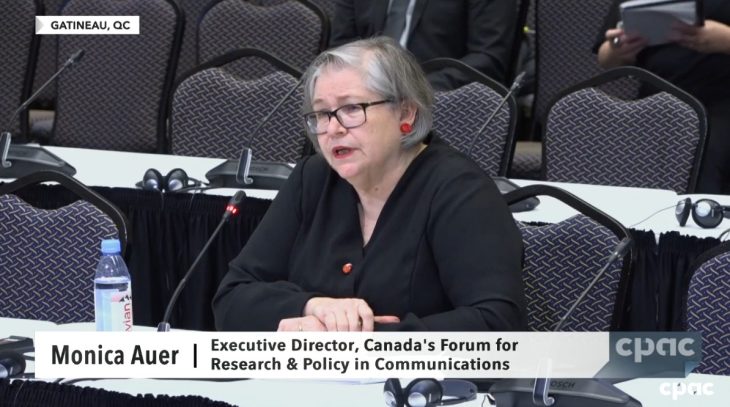
By Monica Auer, executive director of the Forum for Research and Policy in Communications (FRPC)
Parliament established the CRTC in 1968 to implement a new Broadcasting Policy for Canada and added telecommunications to its responsibilities in 1975. The CRTC must follow this and other legislation, such as the Accessible Canada Act and other requirements of other federal departments. In 2024, for example, the Treasury Board issued a Trust and Transparency Strategy setting out three strategic objectives for government departments and agencies such as the commission: transparency, accountability and public participation.
The Treasury Board describes “transparency” as the availability of “relevant information in a complete, accurate and timely manner” which gives the public “ready access to information they want and need.”
Yet findings from a study released last week by the Forum for Research and Policy in Communications (FRPC) — a non-partisan, public-interest organization participating in CRTC proceedings since 2013 — raise concerns regarding the CRTC.
As noted in the study, The CRTC’s performance, 1969-2025: Analysis and recommendations, transparency is of special relevance to the commission because, since its establishment, it committed to engaging with the public and often invites comments from the public about its notices of consultation or the applications it posts. Some CRTC notices review past policies and decisions, but few people know that the CRTC’s decisions’ database excludes all the documents it published from 1968 to 1984 – at least 16,000 decisions and notices – just when it began licensing many new broadcasters and building the foundation of most of its current policies. Incomplete historical records can obscure the CRTC’s past reasoning and evidence, and raise concerns about the CRTC’s ignoring or erasing its history.
Today, moreover, the CRTC’s consultations often seek answers but omit relevant facts. In February 2025, for instance, the CRTC invited answers to 50 questions about Canadian audio content. Although 120 or more CRTC staff began work to regulate online streaming services in 2021, the 2025 notice set out no information about the level of Canadian audio programming previously or currently broadcast. Lack of transparency in this case yields inefficiency: since the CRTC’s notices rarely set out ‘its case’ and evidence, participants in its proceedings often spend time assembling evidence for their submissions which the CRTC may already have.
The federal open data site does hold a virtual cornucopia of CRTC facts – 17 spreadsheets and some 325 separate tables (tabs). But since the CRTC has been collecting broadcasting data for fifty years, why do two-thirds of its 146 open data broadcasting tables describe a single decade? Why do 177 of its 179 telecom tables present fewer than 15 years of data? Such short term data prevent current or proposed policies from being modelled, while the CRTC’s unannounced practice of frequently changing the presentation of its data stymies comparisons over time.
When the CRTC invited comments about closed-captioning in June 2024, it highlighted the importance of complaints to improving accessibility but was silent about the number of complaints it had received. It later provided some figures in an access-to-information response – but added that its “data system is outdated, and the reporting has proven to be unreliable.” Regrettably, this admission raises doubts about whether the CRTC’s data system is fit for purpose.
Transparency also matters to broadcasters seeking new, amended or renewed broadcasting licences and to telecoms applying for tariff approvals or service changes. The CRTC’s procedural regulations state that it “must post on its website all applications” [italics added] that meet its service, style and substance requirements. It does not. CRTC access-to-information responses confirm that from 2016 to 2020 it did not post at least 60 broadcasting applications. It is therefore unknown how many applications never make it to the CRTC’s public agenda and why, or whether others share the concerns the applications raise.
As for decision-making timeliness, the CRTC’s Departmental Results Report 2023-24 reveals it made decisions concerning four out of five of the applications it received within four months of the intervention deadlines set by the CRTC. Yet the CRTC’s former standards were to decide all Part 1 decisions within 4 months – although from 2017/18 to 2022/23 it failed to meet those standards. Three years ago more than a dozen organizations petitioned cabinet about problems with the CRTC’s renewal of CBC’s licences – and cabinet ordered the CRTC to rehear and consider the decision: as the licences are currently scheduled to expire in two years, the CRTC’s delay has rendered this order moot.
A critical gap in transparency is that the CRTC’s standards ignore how long applicants must wait for its decisions. In mid-May 2025, the “Broadcasting Applications Report” published by the CRTC for 2024 listed 102 applications and described 75 as having been determined; it took the CRTC an average of 6.5 months after these applications were filed to issue decisions, with 12 applications waiting from 6.9 months to just over a year. Meanwhile, 27 applications in the 2024 list were shown as not having been decided – waiting for a determination for an average of 8.5 months, with twelve applications having waiting from 8.8 to just over a year. At least one of these applicants had asked the CRTC to expedite its decisions; the commission had not issued a decision by the end of July 2025 for the application filed by OUTtv more than nine months ago in mid-October 2024, and for which the public participation phase ended four months ago.
CRTC’s opacity about application filing dates and the fact that its lists of applications are not updated regularly obscures the impact of untimely decision-making. While delays of half a year or longer certainly inconvenience the broadcasting services of large companies like Bell, the same delays put smaller broadcasters such as OUTtv (that, after filing its renewal application in 2019, waited three years for a CRTC decision) at real risk of closure.
Other CRTC processes are entirely concealed from scrutiny. The membership, meetings, work and decisions of three committees established by the CRTC’s by-laws are unknown, as are CRTC’s processes for resolving disagreements between programming and distribution broadcasters.
While the CRTC issued a scant dozen decisions about such disputes from 2016 to 2021, a CRTC access-to-information response shows that its staff hosted 211 dispute-resolution processes over this six-year period — an average of three per month. The 158 processes with start and end dates took an average of 7.6 months to conclude, with more than two-thirds taking from six months to four years to terminate: since ADR processes are generally supposed to be more efficient in resolving disagreements, the time consumed by the CRTC ADR process raises concerns. But the overarching problem is that non-transparency about the volume of disputes means that only the parties involved and the CRTC realize that disputes between broadcasters have become a feature, not an abnormality, of today’s broadcasting system – if so, should the CRTC use its time to oversee a continuous stream of disputes, or evaluate its regulatory policies to tackle what may well be systemic problems?
The CRTC’s website states its commitment “to providing open and transparent information about our operations and resources to the public so that Canadians and Parliament are better able to hold the government and public sector officials accountable.” FRPC supports this commitment and urges the commission to take immediate steps to address any procedural or other roadblocks to its achievement.
HIGH QUALITY JOURNALISM REQUIRES AN INVESTMENT.
Cartt.ca publishes breaking news, in-depth feature stories, analysis, and opinion geared specifically for those working in the cable, radio, television, and telecom industries in Canada.
Breaking news, top-notch analysis and commentary is posted as it happens while twice-weekly newsletters compile those stories and deliver them directly to more than 4,000 industry subscribers. Cartt.ca offers credible journalism for the industry professional.




